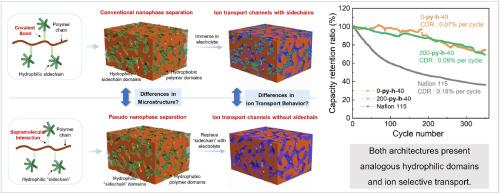Supramolecular pseudo-nanophase separation enables ion transport parity with conventional membranes
IF 9
1区 工程技术
Q1 ENGINEERING, CHEMICAL
引用次数: 0
Abstract
Supramolecular-engineered pseudo-nanophase separation offers a compelling strategy for fabricating ion-conducting membranes with industrial scalability while maintaining rapid ion transport and chemical robustness. However, fundamental distinctions between pseudo-nanophase separation and its conventional counterpart remain poorly understood. We engineered ion-conducting membranes featuring snowflake-like multi-branched hydrophilic sidechains through covalent and supramolecular grafting, inducing conventional versus pseudo-nanophase separation. Comparative analysis revealed both architectures form analogous 4–11 nm hydrophilic domains (∼7 nm median) through hydrophobic/hydrophilic segregation. Though conventional domains contain tethered sidechains versus sulfuric acid solutions in pseudo-separated counterparts, the membranes demonstrate comparable area resistances (0.25 vs 0.24 Ω cm2) and vanadium permeabilities (1.1 vs 1.3 10−9 m2 s−1), leading to indistinguishable efficiencies and cycling stability in vanadium redox flow batteries. The observed functional equivalence, wherein proton transfer kinetics and vanadium-ion exclusion are largely insensitive to the molecular constitution of the engineered nanochannels, challenges conventional membrane design paradigms emphasizing covalent architectures for optimal ion selectivity. This finding advances the mechanistic understanding of nanochannel-mediated ion transport and substantiates the high credibility and efficiency of the pseudo-nanophase separation strategy.

超分子伪纳米相分离使离子传输与常规膜相同
超分子工程伪纳米相分离为制造具有工业可扩展性的离子导电膜提供了一种引人注目的策略,同时保持了快速离子传输和化学稳健性。然而,伪纳米相分离和传统纳米相分离之间的基本区别仍然知之甚少。我们通过共价和超分子接枝设计了具有雪花状多支亲水性侧链的离子导电膜,诱导常规和伪纳米相分离。对比分析表明,这两种结构通过疏水/亲水分离形成类似的4-11 nm亲水结构域(中间值约7 nm)。虽然传统结构域与硫酸溶液相比含有系留侧链,但膜具有相当的面积电阻(0.25 vs 0.24 Ω cm2)和钒渗透率(1.1 vs 1.3 × 10−9 m2 s−1),从而在钒氧化还原液流电池中具有不可区分的效率和循环稳定性。观察到的功能等效性,其中质子转移动力学和钒离子排斥在很大程度上对工程纳米通道的分子结构不敏感,挑战了传统的强调共价结构以获得最佳离子选择性的膜设计范式。这一发现促进了对纳米通道介导离子传输机制的理解,并证实了伪纳米相分离策略的高可信度和高效率。
本文章由计算机程序翻译,如有差异,请以英文原文为准。
求助全文
约1分钟内获得全文
求助全文
来源期刊

Journal of Membrane Science
工程技术-高分子科学
CiteScore
17.10
自引率
17.90%
发文量
1031
审稿时长
2.5 months
期刊介绍:
The Journal of Membrane Science is a publication that focuses on membrane systems and is aimed at academic and industrial chemists, chemical engineers, materials scientists, and membranologists. It publishes original research and reviews on various aspects of membrane transport, membrane formation/structure, fouling, module/process design, and processes/applications. The journal primarily focuses on the structure, function, and performance of non-biological membranes but also includes papers that relate to biological membranes. The Journal of Membrane Science publishes Full Text Papers, State-of-the-Art Reviews, Letters to the Editor, and Perspectives.
 求助内容:
求助内容: 应助结果提醒方式:
应助结果提醒方式:


